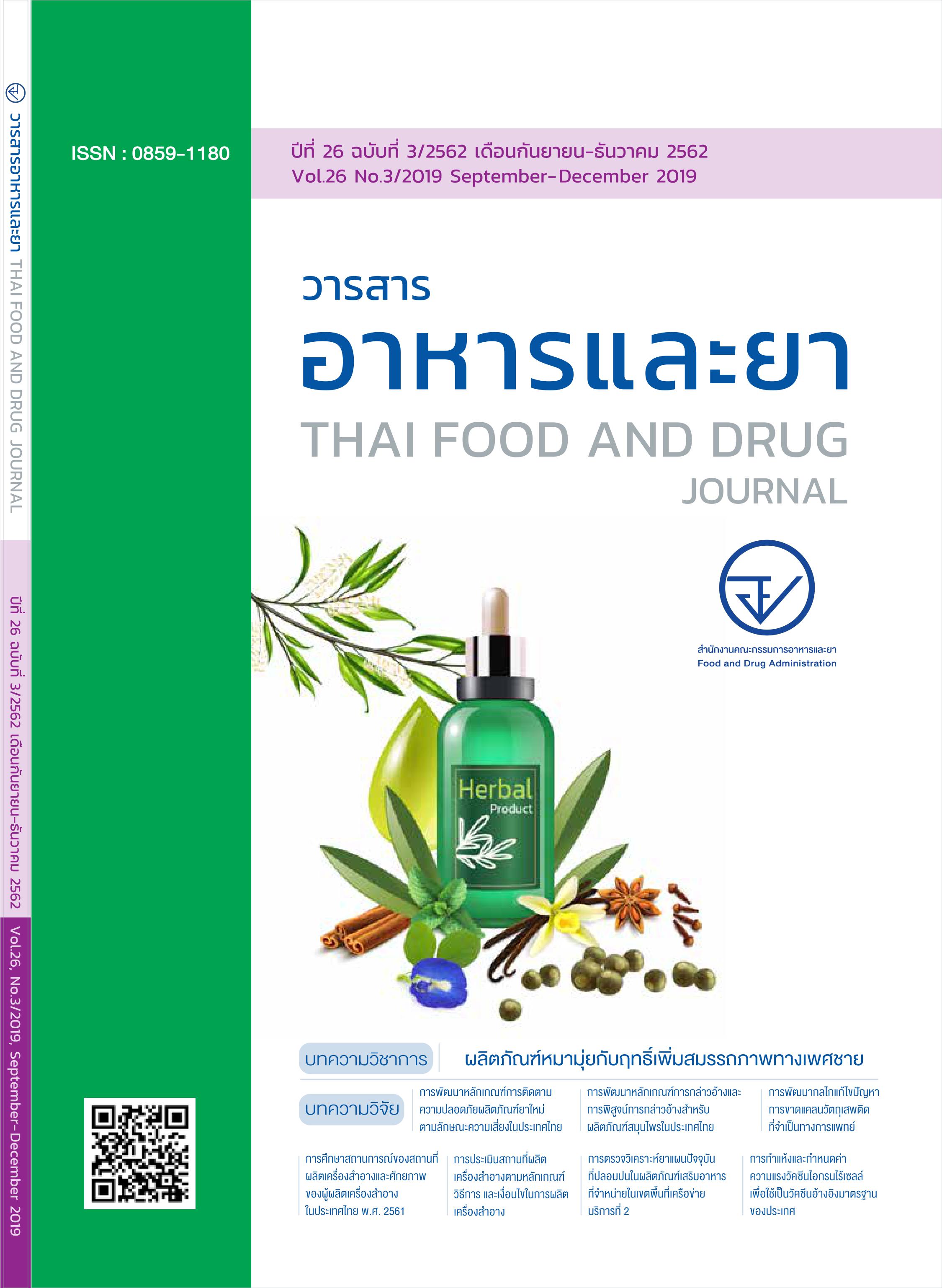การศึกษาสถานการณ์ของสาถานที่ผลิตเครื่องสำอางและศักยภาพของผู้ผลิตเครื่องสำอางในประเทศไทย พ.ศ. 2561
Main Article Content
บทคัดย่อ
การศึกษานี้มีวัตถุประสงค์เพื่อประเมินสถานการณ์และวิเคราะห์สภาพปัญหาสถานที่ผลิตเครื่องสำอางหลังการออกประกาศกระทรวงสาธารณสุข เรื่อง หลักเกณฑ์ วิธีการ และเงื่อนไขในการผลิตหรือนำเข้าเครื่องสำอางพ.ศ. 2561 และประเมินศักยภาพของผู้ผลิตเครื่องสำอางในการปฏิบัติตามประกาศฯ ผู้วิจัยจึงเก็บข้อมูลจากรายงานผลการสำรวจสถานที่ผลิตเครื่องสำอางทั่วประเทศ จำนวน 11,525 แห่ง และประเมินศักยภาพของผู้ผลิตเครื่องสำอางเฉพาะในเขตกรุงเทพมหานคร จำนวน 321 แห่ง ซึ่งเป็นข้อมูลตั้งแต่เดือนกรกฎาคม 2561 – ตุลาคม 2561 รูปแบบงานวิจัยใช้สถิติเชิงพรรณนาภาคตัดขวาง อธิบายข้อมูลลักษณะกลุ่มตัวอย่าง โดยแจกแจงเป็นร้อยละ ค่าเฉลี่ย และส่วนเบี่ยงเบนมาตรฐาน ผลการศึกษาข้อมูลดังกล่าวพบว่า มีสถานที่อยู่จริง 8,865 แห่ง (ร้อยละ 76.92) แต่สถานที่ผลิตได้รับการตรวจประเมิน 8,788 แห่ง ผ่านเกณฑ์การประเมิน 468 แห่ง (ร้อยละ 5.33) ไม่ผ่าน 8,320 แห่ง (ร้อยละ 94.67) สภาพปัญหาที่พบ เช่น ไม่พบสถานที่ตามที่แจ้งไว้ สถานที่ปิด เปลี่ยนสภาพหรือ เป็นที่รกร้าง เป็นต้น ผลการศึกษาศักยภาพของผู้ผลิตเครื่องสำอางในเขตกรุงเทพมหานคร เปรียบเทียบกับ กลุ่มผู้ผลิตตามลักษณะโครงสร้างอาคารผลิตพบว่า อาคารโรงงานได้รับคะแนนเฉลี่ยมากกว่าอาคารพาณิชย์ และ มากกว่าอาคารบ้านพักอาศัยอย่างมีนัยสำคัญทางสถิติ (p-value < 0.001) ศักยภาพในการปฏิบัติตามหมวดข้อบังคับ ได้แก่ หมวดสถานที่ผลิตการแยกสัดส่วนของสถานที่พบว่า อาคารโรงงานอยู่ในระดับดีกว่าอาคารพาณิชย์และอาคารบ้านพักอาศัยอย่างมีนัยสำคัญทางสถิติ หมวดเครื่องมือพบว่า อยู่ในระดับดีทั้งสามกลุ่มไม่ต่างกันหมวดการดำเนินการผลิตในส่วนของสภาพความสะอาดและป้ายบ่งชี้พบว่า อาคารโรงงานจะอยู่ในระดับดีกว่าอย่างมีนัยสำคัญทางสถิติ สำหรับการผลิตตามเอกสารสูตรแม่บทพบว่า อาคารพาณิชย์และอาคารบ้านพักอาศัยอยู่ในระดับที่ต้องปรับปรุง ต่างจากอาคารโรงงานอย่างมีนัยสำคัญทางสถิติ หมวดการควบคุมคุณภาพพบว่าอาคารโรงงานอยู่ในระดับดี อีกสองกลุ่มอยู่ในระดับพอใช้ ต่างกันอย่างมีนัยสำคัญทางสถิติ หมวดเอกสารการผลิตการจัดทำเอกสารสูตรแม่บทพบว่า อยู่ในระดับที่ต้องปรับปรุงทั้งสามกลุ่มไม่ต่างกัน และการจัดทำบันทึกการผลิตอยู่ในระดับที่ต้องปรับปรุงทั้งสามกลุ่ม โดยกลุ่มอาคารบ้านพักอาศัยอยู่ในระดับต้องปรับปรุงมากกว่ากลุ่มอื่นอย่างมีนัยสำคัญทางสถิติ จากการวิเคราะห์สภาพปัญหาที่ประเมินข้างต้น เพื่อให้การกำกับดูแลสถานที่ผลิตเครื่องสำอาง ปฏิบัติตามประกาศฯภายในปี พ.ศ. 2563 มีข้อเสนอดังนี้ (1) ติดตามตรวจสอบผู้ประกอบการทุกรายก่อนวันที่กฎหมายมีผลบังคับใช้ (2) ประสานหน่วยงานภาครัฐอื่นที่สามารถให้ทุนแก่ผู้ประกอบการในการปรับปรุงพัฒนาสถานที่ผลิต (3) อบรมให้ความรู้แก่ผู้ผลิตโดยเน้นเรื่องการควบคุมคุณภาพและการจัดทำเอกสารการผลิต
Article Details
เอกสารอ้างอิง
(AHCRS) ความตกลงแผนการปรับกฎระเบียน เครื่องสำอางให้สอดคล้องกันในกลุ่มประเทศอาเซียน. ข่าวสารด้านยาและผลิตภัณฑ์สุขภาพ 2556;2:49-54.
2.กระทรวงสาธารณสุข. ประกาศกระทรวงสาธารณสุข พ.ศ. 2551 เรื่อง ยกเลิกการกำหนดเครื่องสำอาง
ควบคุมพิเศษ. ราชกิจจานุเบกษา เล่มที่ 125,ตอนพิเศษ 157 ง (หน้า 17) (ลงวันที่ 25 กันยายน
2551).
3.กระทรวงสาธารณสุข. ประกาศกระทรวงสาธารณสุขพ.ศ. 2551 เรื่อง การกำหนดเครื่องสำอางควบคุม.
ราชกิจจานุเบกษา เล่ม 125 ตอนพิเศษ 157 ง (หน้า 18) (ลงวันที่ 25 กันยายน 2551).
4.กระทรวงสาธารณสุข. ประกาศสำนักงานคณะกรรมการอาหารและยา พ.ศ. 2551 เรื่อง ชี้แจงประกาศกระทรวงสาธารณสุขและประกาศคณะกรรมการเครื่องสำอาง. (ประกาศ ณ วันที่ 5 พฤศจิกายน 2551).
5.พระราชบัญญัติเครื่องสำอาง พ.ศ. 2558. ราชกิจจานุเบกษา เล่มที่ 132 ตอนที่ 86 ก (ลงวันที่ 8
กันยายน 2558).
6.กระทรวงสาธารณสุข. ประกาศกระทรวงสาธารณสุข พ.ศ. 2561 เรื่อง หลักเกณฑ์ วิธีการ และเงื่อนไข
ในการผลิตหรือนำเข้าเครื่องสำอาง พ.ศ. 2561.ราชกิจจานุเบกษา เล่ม 135 ตอนพิเศษ 117 ง
(ลงวันที่ 23 พฤษภาคม 2561).
7.ข้อมูลสถิติมูลค่าการส่งออกเครื่องสำอาง สบู่ และผลิตภัณฑ์รักษาผิว สำนักงานปลัดกระทรวงพาณิชย์
[อินเทอร์เน็ต]. 2561 [เข้าถึงเมื่อ 15 พ.ค. 2561] เข้าถึงได้จาก : http://www.ops3.moc.go.th/
infor/menucomth/stru1_export/export_topn_re/report.asp


